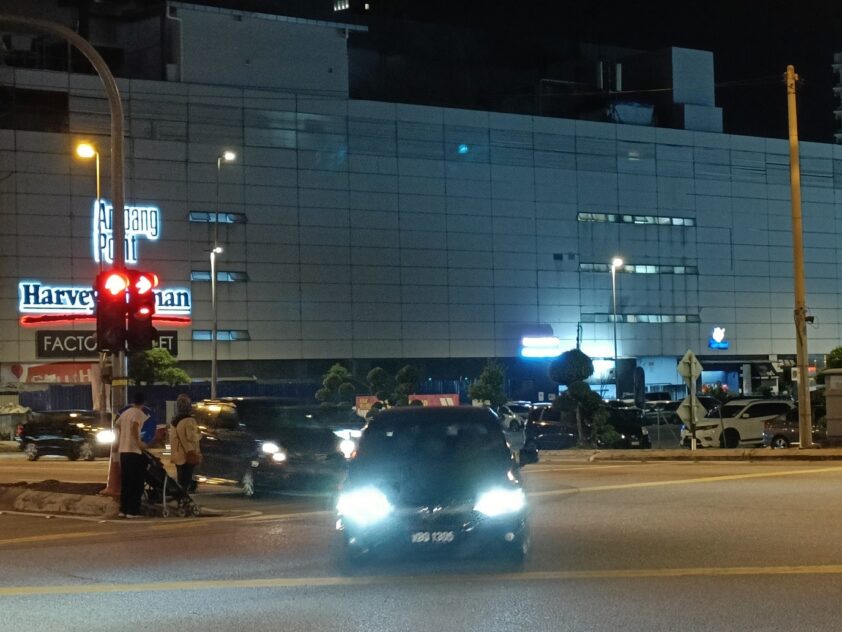AT a bustling intersection near Ampang Point, a mother with a baby in a stroller and an elderly man wait alongside six lanes of traffic, with no pedestrian signal in sight.
Though there’s a pedestrian bridge nearby, it is inaccessible to them. As cars, trucks, and motorcycles speed past, they wait for a chance to cross.
Meanwhile, another pedestrian is stranded in the middle of the road, unable to complete the crossing and forced to wait for a break in traffic.
This scene is typical in Ampang Jaya, reflecting Malaysia’s heavy reliance on cars and the underdevelopment of cycling and walking infrastructure. In the Klang Valley, the quality of walking and cycling facilities varies greatly between municipalities.
Comparing different areas, Ampang Jaya, managed by Majlis Perbandaran Ampang Jaya (MPAJ), stands out for having some of the poorest pedestrian and cyclist infrastructure in the region.
The absence of pedestrian infrastructure
Many roads in Ampang Jaya lack sidewalks. Illegal parking and vendor stalls frequently encroach upon these spaces. Where sidewalks do exist, they are often narrow, uneven, and abruptly end.
The absence of designated pedestrian pathways forces people to walk alongside traffic, heightening the risk of crashes. Crosswalks with pedestrian signals are rare, adding to the danger as pedestrians navigate intersections without safe crossing points.
When crosswalks are present, they are often poorly designed, with curbs that are too high for many, particularly for the OKU. Pedestrian bridges, where available, are often inaccessible to the elderly, people with disabilities, and those with strollers.
Consequences
The lack of pedestrian-friendly infrastructure makes walking both unpleasant and hazardous, leading more people to drive – even for short distances. This increases vehicle traffic, exacerbating congestion and delays.
Roads designed primarily for vehicles encourage speeding, further endangering pedestrians and other road users.
Car dependency disproportionately affects marginalised groups, who may lack access to private transportation or find vehicle ownership financially burdensome. This limits their mobility, access to essential services, and opportunities for economic advancement.
With Malaysia’s ageing population, a car-centric society exacerbates challenges for seniors, leading to social isolation and safety concerns.
Furthermore, excessive car use contributes to air pollution, greenhouse gas emissions, and climate change, reinforcing a harmful, car-centric society.

The need for pedestrian infrastructure
The issue of inadequate pedestrian infrastructure extends beyond Ampang Jaya to the Klang Valley and the nation as a whole.
To promote pedestrian safety and encourage active transportation, it’s essential to prioritise pedestrian-friendly infrastructure.
This includes constructing sidewalks on major roads and in residential and commercial areas, installing crosswalks at intersections, and creating safe and inviting paths for walking and cycling.
Local councils can further encourage residents to adopt these mobility options by organising community walks and bike rides to showcase the new infrastructure.
Improving pedestrian infrastructure can also enhance public transport accessibility, making it easier for even more residents to walk or cycle to train stations.
While the Selangor government’s investment in demand-responsive transit (DRT) vans is commendable, the effectiveness of these services depends on users’ ability to access DRT stops safely.
It’s ironic that local councils are so fixated on “smart solutions” like EV chargers while ignoring basic pedestrian infrastructure.
Investing in electric vehicles is great for reducing emissions, but good sidewalks and crossings can help reduce car use too, making efforts to cut carbon emissions more effective.
Ensuring implementation
The draft Selangor Structure Plan includes valuable proposals to reduce car dependence and promote walking, cycling, and public transit.
However, these ideas need practical implementation. For example, if the plan encourages walking to LRT stations to reduce car use, the routes must be safe and comfortable, with proper sidewalks, crosswalks, and street lighting.
Pathways must be accessible for all, including the elderly, OKU, and parents with strollers.
Regular audits should be conducted to ensure these plans are realised. Local councils that successfully implement these initiatives should be recognised and rewarded, while those that fail should face penalties.
This approach would incentivise local councils to actively work towards the objectives outlined in the plan.
Building a better community
Transforming the Klang Valley into a pedestrian-friendly region requires a collective effort from planners, policymakers, and local communities.
Despite the author’s attempts to address these issues with MPAJ, ADUNs, and councillors, these concerns have been ignored.
It is hoped that MPAJ will eventually take responsibility to improve pedestrian safety. By prioritising pedestrian safety and dignity, we can create a more inclusive, sustainable, and vibrant urban environment that benefits everyone. – Sept 11, 2024
Boo Jia Cher is a Focus Malaysia reader.
The views expressed are solely of the author and do not necessarily reflect those of Focus Malaysia.
Main image: The Star









